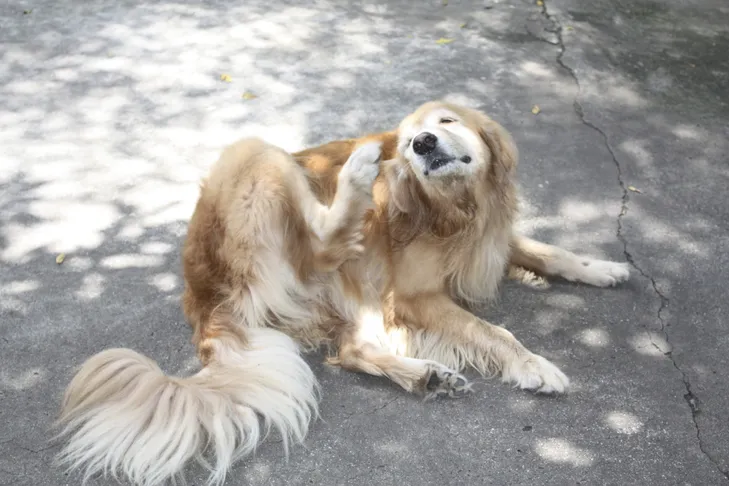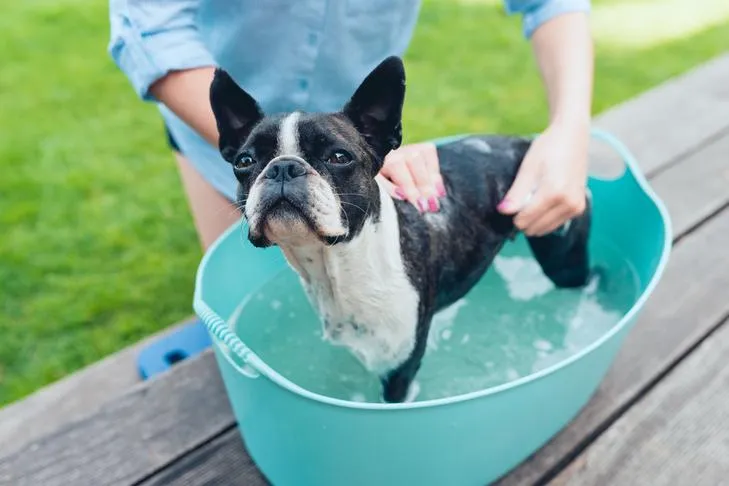The thought of parasites can send shivers down any pet owner’s spine, especially when wondering if those tiny invaders could make their way from furry friends to human family members. If your dog or a member of your family has lice, you may be concerned about how this parasite spreads, particularly the primary question: Can Dog Lice Live In Human Hair? The good news, and a crucial piece of information for all pet parents, is that lice are highly species-specific. This means the lice that thrive on your dog’s blood and skin will not change their dining preferences if they land on you, and vice versa. Therefore, you cannot get lice from your dog, nor can your dog pick up this parasite from you.
However, while human hair is safe from canine lice, there’s plenty of bad news where this parasite is concerned for your dog. Like fleas, a more common pest for dogs, a lice infestation can cause significant discomfort, leading to itching, pain, inflammation, and hair loss. Moreover, it can lead to more serious health issues for your beloved pet. This makes it critically important to understand how to recognize and quickly eradicate dog lice if your canine companion is unlucky enough to pick them up. Understanding the specifics of dog lice is the first step in ensuring your pet’s health and well-being. To learn more about how canine lice differ from human lice, you can read about whether is dog lice the same as human lice to gain a clearer perspective on these species-specific parasites.
The Truth About Dog Lice and Human Hair: Species Specificity Explained
The question of “can dog lice live in human hair” is a common one, stemming from natural concern for both human and pet health. The simple and reassuring answer is no, dog lice cannot establish themselves or reproduce in human hair. This is due to a fundamental biological principle known as species specificity. Lice are highly adapted parasites, meaning each species has evolved to exclusively infest a particular host species.
Lice that infest dogs are small, flat, wingless, six-legged insects that live in the hair and feathers of mammals and birds. Strong hook-like claws at the end of each leg allow them to hang onto the animal’s hair shafts. These claws are precisely tailored to the specific size and texture of the host’s hair shaft or feathers. Human hair is vastly different in diameter and structure from dog hair, making it impossible for canine lice to properly grip onto human strands. Without the ability to hold on, feed, and reproduce, dog lice cannot survive on a human host. The same principle applies in reverse; human head lice cannot infest dogs. For a deeper dive into this topic, explore our article on can dog lice be transferred to humans. They survive on skin debris, sebaceous secretions, feathers, or the blood of the host animal, depending on their type.
What Exactly Are Dog Lice? An Overview of Canine Parasites
Dog lice are small, obligate parasites, meaning they must live on a host to survive. They are flat, wingless insects, typically with six legs, found clinging to the hair shafts of dogs. Their robust, hook-like claws are specially adapted to grasp canine hair, allowing them to remain securely attached to their host.
There are two primary types of lice that can infest dogs, each with distinct feeding habits and characteristics:
Chewing Lice (Mallophaga)
Chewing lice, also known as biting lice, are characterized by their blunt, flat heads. These parasites do not feed on blood. Instead, they survive by eating skin debris, flakes of dead skin, and surface secretions, such as sebaceous oils, found on the dog’s coat.
Two species of chewing lice are known to affect dogs and wild canids: Trichodectes canis and Heterodoxus spiniger. T. canis is found worldwide and typically lives on a host for about 30 days, completing its life cycle entirely on the dog. H. spiniger is more commonly found in tropical regions. While rare on domestic dogs in North America, it has been observed on wild canids like coyotes, red foxes, and gray wolves. Researchers also documented this type of lice on dogs in southeastern Mexico in 2015, highlighting its presence in certain geographical areas.
Sucking Lice (Anoplura)
Sucking lice, in contrast to chewing lice, are blood-feeding parasites. They possess a sharp, pointed mouthpiece, which they use to pierce the dog’s skin and draw blood. This feeding habit makes them more dangerous, as heavy infestations can lead to anemia, particularly in puppies or small, sick, or elderly dogs.
The species of sucking lice that primarily affects dogs is called Linognathus setosus. These parasites are widespread, particularly in tropical and subtropical areas across various continents, including North and South America, Africa, India, and Asia. Their presence can cause more severe irritation and health complications due to their blood-sucking nature.
Recognizing the Signs: How to Spot a Dog Lice Infestation
Identifying a lice infestation early is crucial for effective treatment. Adult lice are typically large enough to be visible to the naked eye, measuring roughly the size of a sesame seed (about 2 to 4 millimeters). These parasites usually range in color from yellow to tan or medium brown. You can often spot the parasites themselves by carefully parting your dog’s hair and examining the hair shaft, especially around the ears, neck, and tail base. They are distinguishable from fleas, which appear very dark and almost black, by their lighter color and slower movement.
Chewing lice tend to move around more freely on the dog’s skin and coat, while sucking lice, much like ticks, embed their piercing mouthparts into the skin to feed. If you suspect an infestation, using a fine-toothed flea comb can help you capture live and dead lice for closer inspection.
One common mistake dog owners make is confusing lice, especially their eggs (nits), with dandruff. A simple way to distinguish between the two is to examine hair removed from your dog. If the small flakes fall off easily, it’s likely dandruff. However, if they cling stubbornly to the hair shaft, resisting efforts to dislodge them, it’s probably lice eggs.
Other signs of a dog lice infestation include:
- Intense Itchiness and Scratching: This is often the most noticeable symptom. Your dog may scratch, bite, or lick excessively at affected areas.
- Rough, Dry, or Matted Coat: The dog’s fur may appear unkempt, greasy, or matted due to irritation and the presence of lice and nits.
- Hair Loss: Persistent scratching can lead to hair loss, particularly around the ears, neck, shoulders, groin, and rectal regions.
- Skin Lesions and Infections: Bites from sucking lice can cause small wounds, which may develop into bacterial skin infections.
- Restless Behavior: Dogs with lice often appear uncomfortable, agitated, and may have difficulty settling down.
- Anemia: In severe cases, especially in small dogs and puppies, a heavy infestation of sucking lice can lead to anemia due to significant blood loss.
- Secondary Parasites: Lice, particularly chewing lice, can transmit tapeworms and other bacteria or parasites.
 Golden Retriever dog scratching its ear, a common sign of a canine lice infestation.
Golden Retriever dog scratching its ear, a common sign of a canine lice infestation.
 Standard Schnauzer puppy scratching its back on the grass, indicating potential dog skin parasites.
Standard Schnauzer puppy scratching its back on the grass, indicating potential dog skin parasites.
How Dogs Contract Lice: Understanding Transmission and Life Cycle
Understanding how dogs get lice is key to preventing infestations. Unlike fleas, lice have limited mobility; they can crawl but are unable to jump, hop, or fly. Furthermore, adult lice are fragile and typically die within a few days if they fall off their host. This means transmission usually occurs through direct contact with another infested animal.
However, direct contact isn’t the only route. Lice can also be passed on from contaminated objects that have been in contact with an infested dog. This includes shared bedding, dog collars, brushes, or other grooming tools. Places where dogs congregate, such as dog daycare centers, boarding kennels, dog parks, or even veterinary clinics, can also pose a risk for transmission if proper hygiene and parasite control aren’t strictly maintained.
The louse life cycle consists of three distinct stages: egg, nymph, and adult.
- Eggs (Nits): The cycle begins when the female louse lays tiny, oval-shaped yellow or white eggs, known as nits. These nits are firmly glued to the base of the dog’s hair shafts. The adhesive substance is so strong that the eggs will not fall off even when the dog is shampooed, making them particularly difficult to remove.
- Nymphs: It takes approximately one week for the eggs to hatch, releasing the immature lice, which are called nymphs. Nymphs are smaller than adults, often no larger than the head of a pin, but they resemble adult lice in appearance and feeding habits. They undergo several molts, growing larger with each stage.
- Adults: After about one to two weeks, nymphs mature into the adult phase, at which point they are capable of reproduction, starting the cycle all over again. According to the Merck Veterinary Manual, it generally takes about 3 to 4 weeks for most lice to go from nits to reproductively capable adults. This relatively short life cycle means an infestation can escalate quickly if not addressed.
 Boston Terrier dog being bathed in a tub, part of effective dog lice treatment and prevention.
Boston Terrier dog being bathed in a tub, part of effective dog lice treatment and prevention.
Effective Strategies for Treating Dog Lice
Treating dog lice requires a systematic approach to eliminate all stages of the parasite. Thankfully, due to the widespread use of monthly flea and tick preventatives, lice infestations are becoming increasingly rare among well-cared-for pet dogs. Today, lice are more commonly found on animals that are old, sick, stray, or living in unsanitary conditions.
Here’s how to effectively get rid of dog lice:
Clipping and Combing: For severe infestations, especially where hair is matted, clipping the affected fur may be necessary. Lice and their eggs are likely to be heavily concentrated in matted hair and can be very difficult to dislodge. Following clipping, use a fine-toothed flea comb to physically remove live and dead lice from the rest of the coat. While a flea comb helps remove visible parasites, it won’t kill the eggs or prevent them from hatching. Always immerse the comb in hot water mixed with a flea shampoo or other insecticide for at least 10 minutes after use to kill any remaining lice or nits.
Insecticidal Treatments: A variety of insecticides are highly effective against dog lice. These include active ingredients such as Fipronil, imidacloprid, and selamectin, often found in topical spot-on treatments. Topical permethrin can also be used on dogs with good effect, but extreme caution must be exercised if cats are present in the household, as many permethrin-based products are highly toxic to felines.
- Always consult your veterinarian about which products are safe and appropriate for your dog, considering their health, breed, and age. As Dr. Jerry Klein, AKC Chief Veterinarian, advises, “Always ask your veterinarian about what products are safe to use on your dog based on his health, breed, and age.” This expert guidance ensures the best and safest outcome for your pet.
- It’s important to note that most insecticide treatments given topically or in shampoos kill nymphs and adult lice but are less effective against the eggs. Therefore, any treatment regimen must be repeated at regular intervals, typically every 1-2 weeks, for at least one month or more, to kill newly hatched nymphs before they can reproduce.
Treating All Pets: If you have a multi-dog household, it is imperative to treat all your dogs simultaneously, even if only one shows signs of infestation. This prevents the parasites from simply moving from one host to another. Consider using a comprehensive treatment that also covers other common parasites, such as a flea tick and intestinal worm treatment for dogs to offer broader protection. Keep any infested dog and their bedding separated from other animals for at least four weeks after treatment to minimize the risk of reinfestation. You might also want to look into a 2 in 1 flea and worm treatment for dogs for a more integrated parasite control approach.
Preventing Future Lice Infestations in Your Dog
Prevention is paramount to keeping your dog free from lice and other parasites. While active treatment eliminates an existing infestation, sustained effort in hygiene and health management will safeguard against future occurrences.
Environmental Sanitation: Thoroughly wash all bedding, dog sweaters, leashes, and collars in hot water. Lice eggs are very sticky and can cling to fabric, so high temperatures are necessary to kill them. Beyond bedding, meticulously clean and vacuum all areas where your dogs spend time, such as crates, floors, and furniture. This removes any adult lice or eggs that may have fallen off the host, preventing a reinfestation cycle. Regular cleaning should be a consistent part of your pet care routine.
Grooming Tool Maintenance: Grooming tools like combs and brushes can easily harbor lice eggs and even live parasites. While cleaning them thoroughly is important, some veterinarians recommend replacing your grooming tools after a lice infestation, as it can be exceedingly difficult to remove all sticky eggs from bristles and teeth. If replacement isn’t feasible, sterilize them by soaking in a strong disinfectant or boiling water.
Holistic Health and Care: Lice generally infest dogs who are in poor health, undernourished, or live in unsanitary conditions. Improving your dog’s overall condition through better nutrition, regular grooming, and a clean, comfortable living environment will significantly boost their natural defenses against parasites.
- Nutrition: A balanced, high-quality diet supports a strong immune system, making your dog more resilient to parasitic threats.
- Grooming: Regular grooming, including brushing and bathing, helps maintain skin and coat health, making it harder for parasites to take hold and easier to spot them early. Consider regular parasite checks as part of your routine, similar to seeking mite treatment for dogs pets at home if needed.
- Housing: Provide a clean, dry, and warm living space. Regularly cleaning your dog’s living areas minimizes environmental risks for parasites.
By combining these preventative measures with prompt and effective treatment when necessary, you can ensure your dog remains happy, healthy, and free from the discomfort of lice infestations.
Conclusion
Understanding the specifics of dog lice is vital for every pet owner, especially the reassuring fact that can dog lice live in human hair is definitively answered with a “no.” Dog lice are species-specific parasites, meaning they cannot infest humans due to their unique biological adaptations. However, this parasite poses a significant threat to canine health, causing intense itching, discomfort, hair loss, and potentially more severe conditions like anemia or the transmission of tapeworms.
Recognizing the signs of a lice infestation, such as persistent scratching, a rough coat, and the visible presence of lice or nits, is the first step toward effective management. Knowing how these parasites spread, primarily through direct contact with infested animals or contaminated items, empowers you to take preventative action. Successful treatment involves a combination of physical removal techniques like clipping and combing, along with veterinarian-prescribed insecticidal treatments, ensuring all life stages of the parasite are targeted through repeated applications. Most importantly, maintaining optimal health for your dog through good nutrition, regular grooming, and a clean living environment is the best long-term strategy for preventing future lice infestations. Always consult your veterinarian for the most appropriate diagnosis and treatment plan tailored to your dog’s specific needs, ensuring their continued well-being.
